Brais Martinez
Multi-scale Image Super Resolution with a Single Auto-Regressive Model
Jun 05, 2025Abstract:In this paper we tackle Image Super Resolution (ISR), using recent advances in Visual Auto-Regressive (VAR) modeling. VAR iteratively estimates the residual in latent space between gradually increasing image scales, a process referred to as next-scale prediction. Thus, the strong priors learned during pre-training align well with the downstream task (ISR). To our knowledge, only VARSR has exploited this synergy so far, showing promising results. However, due to the limitations of existing residual quantizers, VARSR works only at a fixed resolution, i.e. it fails to map intermediate outputs to the corresponding image scales. Additionally, it relies on a 1B transformer architecture (VAR-d24), and leverages a large-scale private dataset to achieve state-of-the-art results. We address these limitations through two novel components: a) a Hierarchical Image Tokenization approach with a multi-scale image tokenizer that progressively represents images at different scales while simultaneously enforcing token overlap across scales, and b) a Direct Preference Optimization (DPO) regularization term that, relying solely on the LR and HR tokenizations, encourages the transformer to produce the latter over the former. To the best of our knowledge, this is the first time a quantizer is trained to force semantically consistent residuals at different scales, and the first time that preference-based optimization is used to train a VAR. Using these two components, our model can denoise the LR image and super-resolve at half and full target upscale factors in a single forward pass. Additionally, we achieve \textit{state-of-the-art results on ISR}, while using a small model (300M params vs ~1B params of VARSR), and without using external training data.
Edge-SD-SR: Low Latency and Parameter Efficient On-device Super-Resolution with Stable Diffusion via Bidirectional Conditioning
Dec 09, 2024



Abstract:There has been immense progress recently in the visual quality of Stable Diffusion-based Super Resolution (SD-SR). However, deploying large diffusion models on computationally restricted devices such as mobile phones remains impractical due to the large model size and high latency. This is compounded for SR as it often operates at high res (e.g. 4Kx3K). In this work, we introduce Edge-SD-SR, the first parameter efficient and low latency diffusion model for image super-resolution. Edge-SD-SR consists of ~169M parameters, including UNet, encoder and decoder, and has a complexity of only ~142 GFLOPs. To maintain a high visual quality on such low compute budget, we introduce a number of training strategies: (i) A novel conditioning mechanism on the low resolution input, coined bidirectional conditioning, which tailors the SD model for the SR task. (ii) Joint training of the UNet and encoder, while decoupling the encodings of the HR and LR images and using a dedicated schedule. (iii) Finetuning the decoder using the UNet's output to directly tailor the decoder to the latents obtained at inference time. Edge-SD-SR runs efficiently on device, e.g. it can upscale a 128x128 patch to 512x512 in 38 msec while running on a Samsung S24 DSP, and of a 512x512 to 2048x2048 (requiring 25 model evaluations) in just ~1.1 sec. Furthermore, we show that Edge-SD-SR matches or even outperforms state-of-the-art SR approaches on the most established SR benchmarks.
Discriminative Fine-tuning of LVLMs
Dec 05, 2024



Abstract:Contrastively-trained Vision-Language Models (VLMs) like CLIP have become the de facto approach for discriminative vision-language representation learning. However, these models have limited language understanding, often exhibiting a "bag of words" behavior. At the same time, Large Vision-Language Models (LVLMs), which combine vision encoders with LLMs, have been shown capable of detailed vision-language reasoning, yet their autoregressive nature renders them less suitable for discriminative tasks. In this work, we propose to combine "the best of both worlds": a new training approach for discriminative fine-tuning of LVLMs that results in strong discriminative and compositional capabilities. Essentially, our approach converts a generative LVLM into a discriminative one, unlocking its capability for powerful image-text discrimination combined with enhanced language understanding. Our contributions include: (1) A carefully designed training/optimization framework that utilizes image-text pairs of variable length and granularity for training the model with both contrastive and next-token prediction losses. This is accompanied by ablation studies that justify the necessity of our framework's components. (2) A parameter-efficient adaptation method using a combination of soft prompting and LoRA adapters. (3) Significant improvements over state-of-the-art CLIP-like models of similar size, including standard image-text retrieval benchmarks and notable gains in compositionality.
FAM Diffusion: Frequency and Attention Modulation for High-Resolution Image Generation with Stable Diffusion
Nov 27, 2024



Abstract:Diffusion models are proficient at generating high-quality images. They are however effective only when operating at the resolution used during training. Inference at a scaled resolution leads to repetitive patterns and structural distortions. Retraining at higher resolutions quickly becomes prohibitive. Thus, methods enabling pre-existing diffusion models to operate at flexible test-time resolutions are highly desirable. Previous works suffer from frequent artifacts and often introduce large latency overheads. We propose two simple modules that combine to solve these issues. We introduce a Frequency Modulation (FM) module that leverages the Fourier domain to improve the global structure consistency, and an Attention Modulation (AM) module which improves the consistency of local texture patterns, a problem largely ignored in prior works. Our method, coined Fam diffusion, can seamlessly integrate into any latent diffusion model and requires no additional training. Extensive qualitative results highlight the effectiveness of our method in addressing structural and local artifacts, while quantitative results show state-of-the-art performance. Also, our method avoids redundant inference tricks for improved consistency such as patch-based or progressive generation, leading to negligible latency overheads.
A Bayesian Approach to Data Point Selection
Nov 06, 2024Abstract:Data point selection (DPS) is becoming a critical topic in deep learning due to the ease of acquiring uncurated training data compared to the difficulty of obtaining curated or processed data. Existing approaches to DPS are predominantly based on a bi-level optimisation (BLO) formulation, which is demanding in terms of memory and computation, and exhibits some theoretical defects regarding minibatches. Thus, we propose a novel Bayesian approach to DPS. We view the DPS problem as posterior inference in a novel Bayesian model where the posterior distributions of the instance-wise weights and the main neural network parameters are inferred under a reasonable prior and likelihood model. We employ stochastic gradient Langevin MCMC sampling to learn the main network and instance-wise weights jointly, ensuring convergence even with minibatches. Our update equation is comparable to the widely used SGD and much more efficient than existing BLO-based methods. Through controlled experiments in both the vision and language domains, we present the proof-of-concept. Additionally, we demonstrate that our method scales effectively to large language models and facilitates automated per-task optimization for instruction fine-tuning datasets.
MobileQuant: Mobile-friendly Quantization for On-device Language Models
Aug 25, 2024
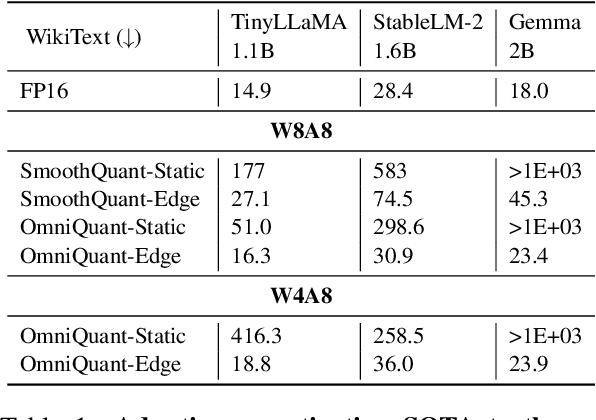

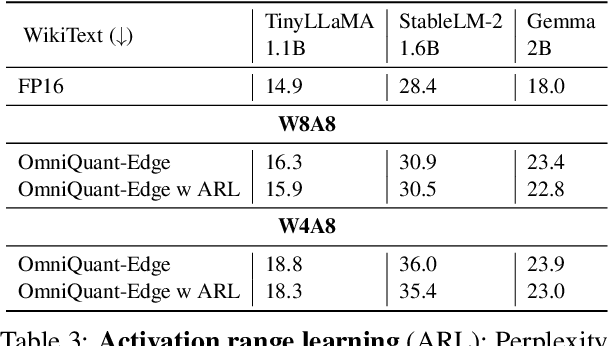
Abstract:Large language models (LLMs) have revolutionized language processing, delivering outstanding results across multiple applications. However, deploying LLMs on edge devices poses several challenges with respect to memory, energy, and compute costs, limiting their widespread use in devices such as mobile phones. A promising solution is to reduce the number of bits used to represent weights and activations. While existing works have found partial success at quantizing LLMs to lower bitwidths, e.g. 4-bit weights, quantizing activations beyond 16 bits often leads to large computational overheads due to poor on-device quantization support, or a considerable accuracy drop. Yet, 8-bit activations are very attractive for on-device deployment as they would enable LLMs to fully exploit mobile-friendly hardware, e.g. Neural Processing Units (NPUs). In this work, we make a first attempt to facilitate the on-device deployment of LLMs using integer-only quantization. We first investigate the limitations of existing quantization methods for on-device deployment, with a special focus on activation quantization. We then address these limitations by introducing a simple post-training quantization method, named MobileQuant, that extends previous weight equivalent transformation works by jointly optimizing the weight transformation and activation range parameters in an end-to-end manner. MobileQuant demonstrates superior capabilities over existing methods by 1) achieving near-lossless quantization on a wide range of LLM benchmarks, 2) reducing latency and energy consumption by 20\%-50\% compared to current on-device quantization strategies, 3) requiring limited compute budget, 4) being compatible with mobile-friendly compute units, e.g. NPU.
CLIP-DPO: Vision-Language Models as a Source of Preference for Fixing Hallucinations in LVLMs
Aug 19, 2024



Abstract:Despite recent successes, LVLMs or Large Vision Language Models are prone to hallucinating details like objects and their properties or relations, limiting their real-world deployment. To address this and improve their robustness, we present CLIP-DPO, a preference optimization method that leverages contrastively pre-trained Vision-Language (VL) embedding models, such as CLIP, for DPO-based optimization of LVLMs. Unlike prior works tackling LVLM hallucinations, our method does not rely on paid-for APIs, and does not require additional training data or the deployment of other external LVLMs. Instead, starting from the initial pool of supervised fine-tuning data, we generate a diverse set of predictions, which are ranked based on their CLIP image-text similarities, and then filtered using a robust rule-based approach to obtain a set of positive and negative pairs for DPO-based training. We applied CLIP-DPO fine-tuning to the MobileVLM-v2 family of models and to LlaVA-1.5, in all cases observing significant improvements in terms of hallucination reduction over baseline models. We also observe better performance for zero-shot classification, suggesting improved grounding capabilities, and verify that the original performance on standard LVLM benchmarks is overall preserved.
You Only Need One Step: Fast Super-Resolution with Stable Diffusion via Scale Distillation
Jan 30, 2024

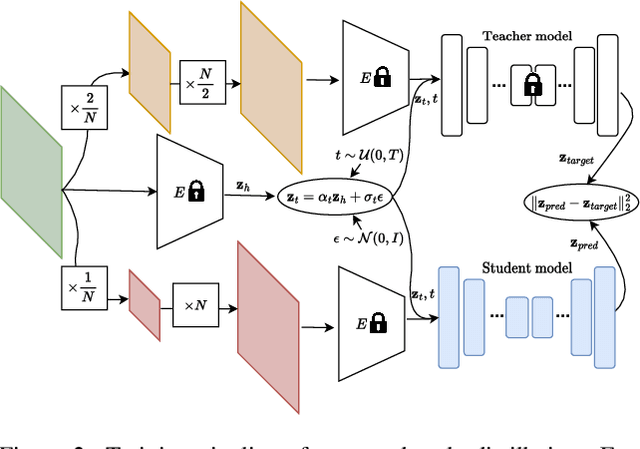

Abstract:In this paper, we introduce YONOS-SR, a novel stable diffusion-based approach for image super-resolution that yields state-of-the-art results using only a single DDIM step. We propose a novel scale distillation approach to train our SR model. Instead of directly training our SR model on the scale factor of interest, we start by training a teacher model on a smaller magnification scale, thereby making the SR problem simpler for the teacher. We then train a student model for a higher magnification scale, using the predictions of the teacher as a target during the training. This process is repeated iteratively until we reach the target scale factor of the final model. The rationale behind our scale distillation is that the teacher aids the student diffusion model training by i) providing a target adapted to the current noise level rather than using the same target coming from ground truth data for all noise levels and ii) providing an accurate target as the teacher has a simpler task to solve. We empirically show that the distilled model significantly outperforms the model trained for high scales directly, specifically with few steps during inference. Having a strong diffusion model that requires only one step allows us to freeze the U-Net and fine-tune the decoder on top of it. We show that the combination of spatially distilled U-Net and fine-tuned decoder outperforms state-of-the-art methods requiring 200 steps with only one single step.
Graph Guided Question Answer Generation for Procedural Question-Answering
Jan 24, 2024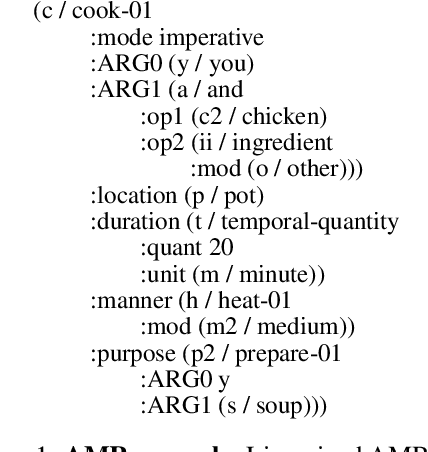
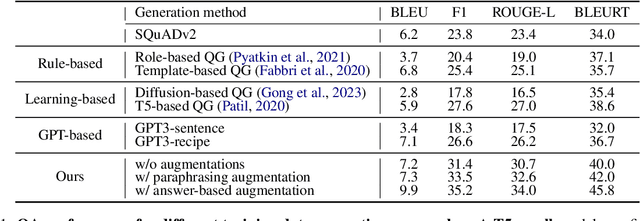
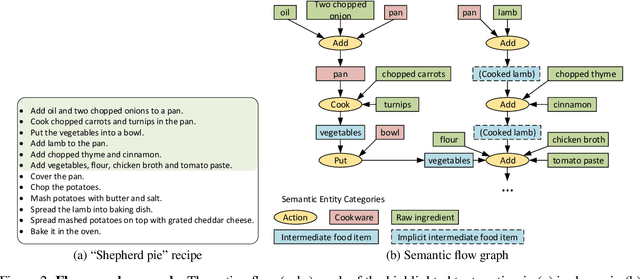
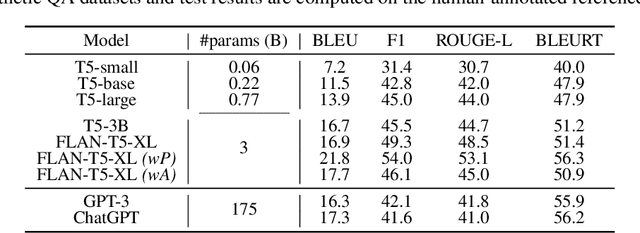
Abstract:In this paper, we focus on task-specific question answering (QA). To this end, we introduce a method for generating exhaustive and high-quality training data, which allows us to train compact (e.g., run on a mobile device), task-specific QA models that are competitive against GPT variants. The key technological enabler is a novel mechanism for automatic question-answer generation from procedural text which can ingest large amounts of textual instructions and produce exhaustive in-domain QA training data. While current QA data generation methods can produce well-formed and varied data, their non-exhaustive nature is sub-optimal for training a QA model. In contrast, we leverage the highly structured aspect of procedural text and represent each step and the overall flow of the procedure as graphs. We then condition on graph nodes to automatically generate QA pairs in an exhaustive and controllable manner. Comprehensive evaluations of our method show that: 1) small models trained with our data achieve excellent performance on the target QA task, even exceeding that of GPT3 and ChatGPT despite being several orders of magnitude smaller. 2) semantic coverage is the key indicator for downstream QA performance. Crucially, while large language models excel at syntactic diversity, this does not necessarily result in improvements on the end QA model. In contrast, the higher semantic coverage provided by our method is critical for QA performance.
SimDETR: Simplifying self-supervised pretraining for DETR
Jul 28, 2023Abstract:DETR-based object detectors have achieved remarkable performance but are sample-inefficient and exhibit slow convergence. Unsupervised pretraining has been found to be helpful to alleviate these impediments, allowing training with large amounts of unlabeled data to improve the detector's performance. However, existing methods have their own limitations, like keeping the detector's backbone frozen in order to avoid performance degradation and utilizing pretraining objectives misaligned with the downstream task. To overcome these limitations, we propose a simple pretraining framework for DETR-based detectors that consists of three simple yet key ingredients: (i) richer, semantics-based initial proposals derived from high-level feature maps, (ii) discriminative training using object pseudo-labels produced via clustering, (iii) self-training to take advantage of the improved object proposals learned by the detector. We report two main findings: (1) Our pretraining outperforms prior DETR pretraining works on both the full and low data regimes by significant margins. (2) We show we can pretrain DETR from scratch (including the backbone) directly on complex image datasets like COCO, paving the path for unsupervised representation learning directly using DETR.
 Add to Chrome
Add to Chrome Add to Firefox
Add to Firefox Add to Edge
Add to Edge